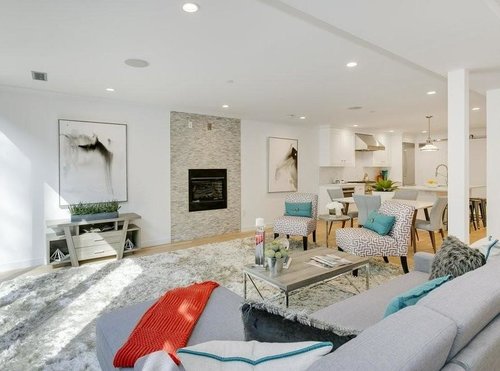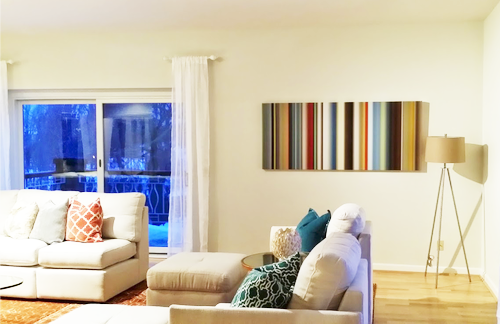by Carolyn Edlund
Interested in growing revenue for your art business? This market can provide opportunities and repeat customers.

"Splash I" and "Splash II" india ink on canvas, 36″ x 48″ by Joyce Creiger
Stagers are professionals who work with real estate agents to help them sell homes by enhancing interiors for the best possible presentation. Realtors know that selling is more effective, and perceived values increase, when prospective customers walk through rooms that are beautifully designed and decorated. This is where the stager can be an essential partner to the agent and the seller.
Since interior furnishings and accessories are the stager's stock-in-trade, artwork is frequently needed to complete the look and encourage buyers to make an offer.
Stagers may work with art consultants to find artwork suitable for their use, but artists can work directly with stagers as well. I recently interviewed Joyce Creiger, founder of Boston Art Rentals and Art Specifier, to learn how the staging business works and how artists can participate and profit from this market.
AS: How would you define the opportunities that artists have today to work with stagers?
JC: I think the greatest opportunities might be with local stagers within a 50-mile radius of your studio or where you store your artwork. Generally, the stagers like to actually see the works of art in your studio, or at least on a well-organized website where they can make selections. Going further than 50 miles is a stretch for both the stager and for the artist. Many stagers want the artist to bring the works to the home or condo they are staging once they have made selections, so the 50-mile radius is about the max that makes sense both from a financial and practical point of view.
Most stagers have a number of artworks that they've acquired over their career; however, rarely do they have enough for all the homes they are staging. The time of year when homes sales are at their peak would be the most opportune time to work with them. However, I highly recommend contacting them when business is slow, so you can get their attention. As the season improves, they get very busy and have little time to visit studios, or to even take a phone call for that matter. Developing a relationship with the stager is key. Get to know how they work, what they need and how to best be their right arm. They need your help but are so busy with other areas of the staging that the art often drops to the bottom of the list until the end when they are rushed and cranky.

"Stripes" digital painting on canvas, 36″ x 72″ by Eddy Stahowiak
AS: What types of art are appropriate for placement in properties that are for sale?
JC: Like any business, knowing your client is key. Many designers and stagers only do one type of design work that they are known for, but that is not true with stagers. Stagers must stage for the home they are given by the realtor. It could be a contemporary house or condo one time and the next a Tudor, so it is important to be able to recognize what type of art is appropriate for each type of home.
If you are only an abstract painter, you might be limited to working on contemporary homes, and the opposite might be true if you only paint traditional landscapes appropriate for a more traditional home. However, stagers will differ, and some like to mix things up a bit to appeal to a broader audience. Remember it is their job to stage the home so anyone would feel comfortable in the environment and see themselves living there.
I think knowing the designer or stager and knowing how they work is key, so I often recommend visiting their website or the website of the realtors they work with to get a better handle on what they like to use for artwork. You might be surprised that the most traditional home gets a very contemporary update and the most contemporary home gets played down a bit to attract a broader audience. It can be tricky, but looking at the past projects sold by the realtor using that stager, or viewing the stager's website, will clue you in to a lot of information you might not glean from just speaking to them on the phone.
Be prepared, know your client, know your realtor and deliver what they are looking for. This is a case where selling doesn't work. They know what they want, and they want you to listen to them.
AS: How can an artist expect to be paid for their work, and how are contracts written?
JC: Depending on how well and how often you work with a particular stager, you might bill them or bill their client. It often depends on how the stager bills for their services. The stager will tell you upfront what they expect and when you will get paid.
I prefer to get paid in advance by their client and bill their client directly, but that doesn't always happen. Don't expect this to be a get rich quick scheme; it is a long haul and repeat business is the best. You might earn around $25-$50-$75/month for each piece, depending on the size. I prefer to have my own installer install the work, so I know that it is well cared for and properly transported, and I charge extra for that. The smaller the piece the less you will receive, and the larger the piece the more you should expect. The larger pieces are more expensive to frame and to handle, so it is only fair to get more money for them.
AS: If an artist wants to get involved with selling and renting to stagers, how can they research opportunities and contact prospects?
JC: Your local Google listings should identify most of the interior designers in your area and most of them now do staging, but a simple phone call would let you know. In the meantime, when you call always ask them if they would like to see your artwork, as you never know if they have a client interested in artwork and yours is the perfect piece. When marketing yourself, never lose the opportunity to get in front of a prospect.
I find LinkedIn is a great resource for finding prospects as well. There are also national organizations that you can research for stagers. Like any professional, going to the national or regional or local organizations always is a great place to start. Local staging organizations often hold meetings where they invite guests to talk about their products or services. These are often held at designer's offices or even local furniture rental places.